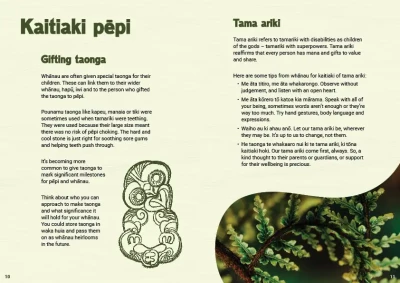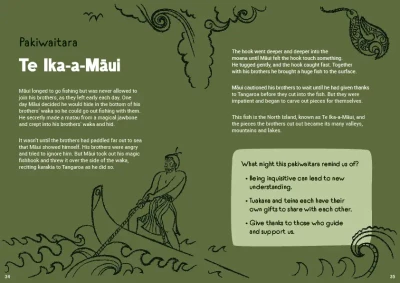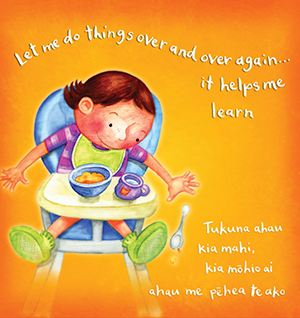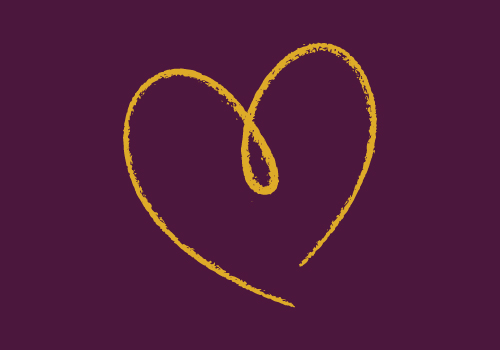
Learning to feed myself
Children’s growing independence means they want to do things for themselves. Learning to feed themselves is messy but parents can make it a positive experience.
Children are becoming more independent at this age. They realise they’re a separate person from their parents and capable of doing many things by themselves. This is part of normal, healthy toddler development. Their fine motor skills are improving, and they can usually pick up food and put it in their mouth without help.
Independence
Whakatipu Te Pihinga 3 (page 8) says ‘We have started to give pēpi finger foods. Pēpi loves the chance to eat without our help.’
Whakatipu Te Pihinga 3 (page 23), pēpi says: ‘I like to do things myself, just like Māui Tikitiki.’
If it’s appropriate, share the pakiwaitara called ‘Te-Ika-a-Māui’ in Te Pihinga 3 (pages 34–35) with whānau.
Māui is the youngest brother and has a mind of his own. Because his brothers won’t let him go on their fishing trips, he secretly makes a fishhook and creeps onto their waka. Māui then fishes up the North Island ( Te-Ika-a-Māui ).
Like Māui, toddlers watch their whānau and will try copying what they’re doing – like feeding themselves.
Conversation ideas
Making up their own mind about eating
Their appetite may decrease as their growth slows a little. With their increasing sense of independence, they may sometimes resist eating or refuse food, which can be hard for parents. Encourage whānau to avoid turning mealtimes into a battle, with mum or dad using threats or treats to get their toddler to eat. Instead, they could offer suitable alternatives, or try again later when their toddler might be hungry.
It's important that tamariki learn to recognise when they’ve had enough – this helps them develop a healthy attitude towards food and to understand what it’s like to feel full.
And just like adults, tamariki will prefer some foods over others.
Self-feeding challenges
Often toddlers make a mess when they’re learning to feed themselves (especially with kai that’s soft and drippy), and this might put parents off. Help whānau feel better about it by seeing it as part of a milestone they might want to celebrate.
Feeding yourself is an important skill that most humans need to learn sooner or later. However, how it’s done differs from home to home. Some families only use their hands to eat, others use knives and forks, others use chopsticks, and so on.
- What does your family use to eat with?
- How will your toddler learn to eat and with what?
- How might you:
- let them practise getting food into their mouth by themselves?
- make sure they get enough to eat?
- make cleaning up easier afterwards?
Some tips to make the clean-up easier are for whānau to spread an old sheet or some newspaper underneath the spot where their toddler is eating to protect the floor. Afterwards, the sheet can be shaken outside or washed, or the newspaper can be thrown out.
Learning to feed themselves
Here’s some things for parents to consider when their toddler is learning to feed themselves:
- Food offers opportunities for experimentation, so expect some mess and take precautions to protect the floor, furniture and clothing if you wish.
- Provide soft food they can pick up with their fingers such as pieces of ripe banana or kiwifruit, or cooked pumpkin or kūmara. Mashed vegetables or yoghurt could be scooped with a spoon.
- If they’re scooping from a bowl, parents can have a spoon for the child and one for themselves or provide finger food for them while parents use the spoon.
- Practice makes progress, so the more practice they get, the faster they’ll learn and the sooner mess will decrease.
- Avoid battles over food and mealtimes – you can’t force a toddler to eat. Offer something else nutritious or leave it till later and try again.
- Helping your toddler to eat nutritious food, recognise what their own body needs (when they are full or hungry) and enjoying the whānau connection around mealtimes will help set tamariki up with lasting healthy habits.
- Appreciate that this is a great way for them to learn hand–eye coordination, and feeding themselves will help them to feel good about their achievements – just like Māui did about his!
Even if toddlers are not eating the same kai as the rest of their whānau, research supports the importance of family eating together. Starting this at the toddler stage sets up positive habits for the family as their tamaiti grows.
Hungry? Or something else?
Understanding their child’s hunger cues can help parents determine if their child needs food, or instead may need something else, like comfort or a sleep.
Sometimes whānau may use fast food or sugary kai as rewards or treats, or as a way to distract or comfort tamariki. To help support healthy kai habits, whānau could use extra play or stories instead.
Helpful resources for whānau
-
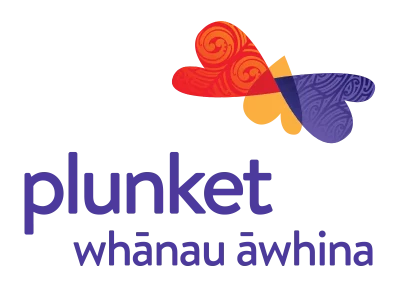
Feeding, food and nutrition
Whānau Āwhina Plunket
Advice on feeding, food and nutrition as tamariki grow and develop.
-

Fussy eating in children
KidsHealth
Fussy eating is common in tamariki. This page will teach you what you can do that can help with fussy eating behaviours.
-
Messy play
Ministry of Education
Messy play gives children the opportunity to experience a wide range of sensory experiences.
-
Fussy eaters
Healthify
Find out about fussy eaters, including some tips for meal times and in between meals.
